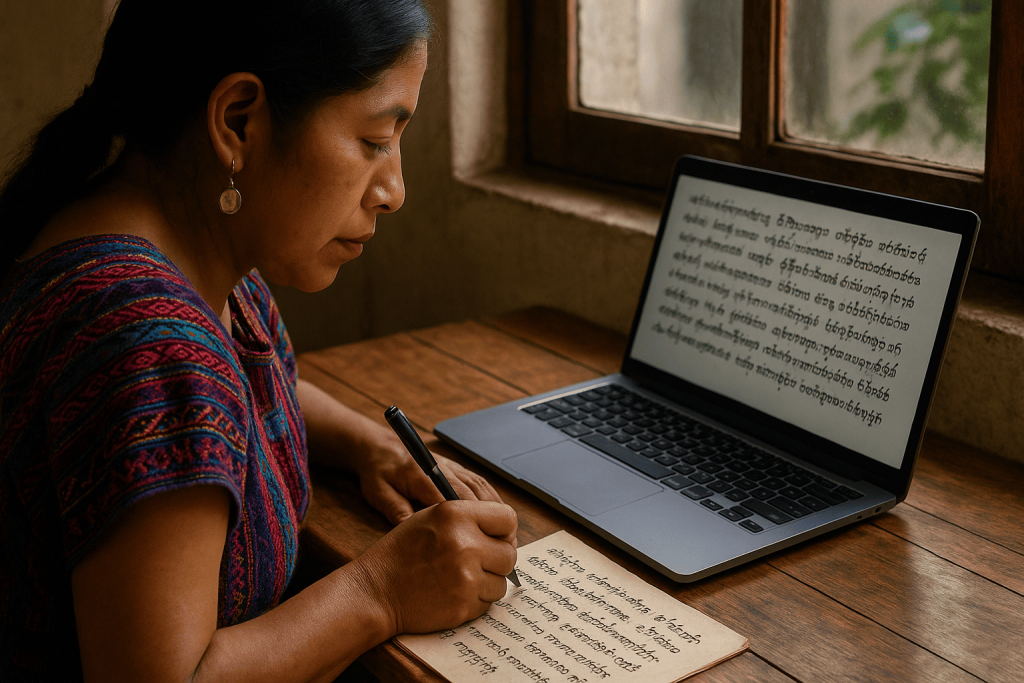Thousands of the world’s languages are slipping toward silence as communities urbanize, migrate, and shift to majority tongues. GPT-class systems promise a different future: machine partners that translate, document, and teach at human speed. But can a neural model really help revive languages with little data, complex morphology, or fragile cultural contexts? This article examines where GPT helps, where it harms, and how to design community-first workflows that preserve both words and the worlds inside them.
What GPT already does well
Modern language models can normalize spelling variants, suggest orthographies, draft bilingual dictionaries, and translate short texts with style notes. They can learn the “shape” of a dialect from a handful of examples, propose inflection tables by analogy, and turn raw interviews into structured field notes. Crucially, they make small language tasks fast: labeling parts of speech, generating example sentences, or producing classroom materials tailored to local contexts.
The bottleneck: data scarcity and fragile evidence
Endangered languages rarely have large, clean corpora. Orthographies may be disputed, texts live in personal notebooks, and audio is trapped on aging media. GPT can generalize from few examples, but it still benefits from carefully curated seed sets. The priority is not “more data at all costs,” but high-quality, consented, and well-annotated samples that represent authentic usage across age, gender, domains, and registers.
Community first, always
Revitalization succeeds when the community owns the process. That means consent for each use, culturally aware curation (what is public, private, or sacred), and local control over models and outputs. GPT should act as a power tool for elders, teachers, and youth—not as an external oracle. Language sovereignty includes hosting decisions, access tiers, and the right to revoke or revise datasets.
Designing a safe translation workflow
Use a “human-in-the-loop” chain: community source → GPT draft → local reviewer → revision log → final archive. Ask the model to output uncertainty flags and alternatives rather than a single confident guess. Require explicit source pointers (e.g., dictionary entries, recorded narratives) so reviewers can verify. For sacred or sensitive material, default to summaries approved by custodians instead of verbatim translation.
From dialects to standards without erasing identity
Many endangered languages exist as dialect continua. GPT can help propose a baseline orthography and a mapping table for local variants, but the goal is not forced standardization. Prefer plural forms: a “pan-dialect” primer plus regional annexes and keyboard layouts that make all variants easy to type and teach.
Teaching materials on tap
Once a seed corpus exists, GPT can generate graded readers, call-and-response dialogues, and scenario-based lessons (market, clinic, fishing trip) with age-appropriate vocabulary. It can create spaced-repetition decks, pronunciation tips aligned to IPA notes, and bilingual glosses tailored to nearby majority languages so children can practice at home with family support.
Speech tech for languages without voice tech
ASR and TTS are critical for accessibility and pride, but low-resource acoustics are hard. GPT can assist by drafting phoneme inventories, minimal pairs, and tongue-twisters to elicit contrasts for recording sessions. With a few hours of community audio, small acoustic models can be bootstrapped, while GPT generates reading prompts to balance phonotactics and prosody.
Morphology: polysynthesis is a feature, not a bug
Languages with rich morphology often stump generic translators. Prompt GPT with explicit morphological paradigms, glossing conventions (e.g., Leipzig rules), and segmentation examples. Ask for analyses that show stems, affixes, and clitics, then back-translate to verify meaning. Over time, assemble a community grammar sketch that the model must consult before generating novel forms.
Preventing hallucinations and “false fluency”
Low-resource settings are prone to confident mistakes. Mitigate by forcing the model to say “unknown,” to offer multiple candidates with confidence notes, and to request context (speaker age, domain, formality). Disallow invention of proverbs or ceremonial terms; require citations or an explicit “unattested” label. A small error in a majority language is noise; in a fragile language, it becomes new “canon” by accident.
Ethics, IP, and cultural protocols
Not every text should be digitized or translated. Elders may allow summaries, paraphrases, or topic labels instead of full release. Respect seasonal or gendered knowledge, clan permissions, and protocols around names of the deceased. License outputs with community-chosen terms, and embed machine-readable provenance so derivatives carry obligations forward.
Practical prompt patterns for linguists and teachers
Ask GPT to act as a “cautious assistant,” bound to a mini-grammar and lexicon you provide. Require structured outputs: lemma, POS, gloss, example, register, dialect tag, and uncertainty. For translation, request two versions (literal interlinear and idiomatic) plus cultural notes. For lesson creation, specify age, theme, and prior vocabulary, and demand a teacher’s guide with activities and assessment suggestions.
Building usable tools: keyboards, fonts, and Unicode
Revitalization fails if people cannot type their language. Pair GPT’s text help with practical infrastructure: mobile keyboards with diacritics, fonts that render properly, and normalization rules so search works across composed characters. Provide copy-paste snippets and style guides for signage, messaging apps, and school worksheets.
Evaluation that respects the language
BLEU scores won’t capture cultural fit. Add community metrics: acceptability to elders, classroom learnability, retention in conversation clubs, and error types that matter (kinship terms, ceremonial vocabulary). Keep a “gotcha” set of tricky constructions for regression testing so new prompts or models don’t degrade hard-won quality.
Field collection, modernized
Use lightweight apps for consented recordings, auto-transcribe with best-effort models, then ask GPT to propose segmentation and glosses for review. Tag stories by genre and sensitivity. Create small, living dictionaries with audio, pictures, and usage notes. The goal is less “big archive someday” and more “useful pieces this month.”
Bridging generations
Youth keep languages alive when they can use them where they live—messaging, music, games. GPT can help coin modern terms (router, playlist) aligned to existing morphology and sound patterns, and suggest playful social content that feels native, not translated. Pair this with elder-led storytelling sessions where GPT produces bilingual summaries to invite newcomers in.
Funding and sustainability
Plan for hosting, training updates, device access, and paid community roles. Favor small, on-device or locally hosted models for privacy and resilience. Document processes so a school or cultural center can continue work if a grant ends. The best technology is the one a community can maintain without outside heroes.
What success looks like
Success is not a perfect translator; it is more speakers using the language daily, more children reading with grandparents, more signage in public, and more songs recorded and shared. GPT’s role is to lower friction: faster materials, cleaner documentation, easier typing, and richer feedback loops—always with cultural authority in human hands.
Conclusion: tools for living languages, not museum pieces
GPT can help save languages—not by replacing speakers, but by accelerating the people who already care for them. With consented data, community governance, cautious prompts, and verification by fluent humans, models become amplifiers of living tradition. Treat the language as a home to inhabit, not an artifact to label, and let AI handle the scaffolding while the community builds the rooms alive with meaning.


